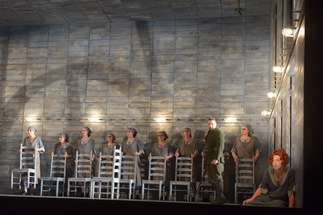|
Back
Der flieglende Holländer Misses the Mark in Montreal Montreal
Salle Wilfrid-Pelletier, Place des Arts
11/10/2012 - & November 13, 15, 17, 2012
Richard Wagner: Der fliegende Holländer
Thomas Gazheli (The Dutchman), Reinhard Hagen (Daland), Maida Hundeling (Senta), Endrik Wottrich (Erik), Kurt Lehmann (The Pilot), Emilia Boteva (Mary)
Chœur de l’Opéra de Montréal, Orchestre Métropolitain, Keri-Lynn Wilson (Conductor)
Marilyn Gronsdal (Director), Allen Moyer (Set and Costumes), Anne Militello (Lighting), Claude Webster (Chorus Master)

E. Wottrich, M. Hundeling (© Yves Renaud)
The most exciting element of Opéra de Montréal’s presentation of Der fliegende Holländer on Saturday evening was the young German soprano Maida Hundeling. Her Senta rang out pure and true. Her sumptuous voice, confident and assured, without a hint of vibrato, projected and sustained the most demanding notes. Although her pitch tended to be slightly off in some of the high Bs and her lower range needs some development, she has a chance of becoming the opera world’s next Nina Stemme.
Of the male principals, all but one was also brought over from Germany for this production. Reinhard Hagen as Daland had the most pleasing voice—warm, rich and well rounded. He projected with ease. The voices of the other two principals, Thomas Gazheli as the Dutchman and Endrik Wottrich as Erik, although full-bodied and powerful, sounded tired and strained. Wottrich, with his overwrought vibrato, recalled a dying Italian tenor. The Canadian Kurt Lehmann as the Pilot had good stage presence and sang robustly but with a pinched, nasal sound. Canadian Emilia Boteva sang Mary with warmth and character.
The most disappointing element was the poor performance of the Orchestre Métropolitain and guest conductor Keri-Lynn Wilson in the pit. Montreal’s “second orchestra”, whose principal conductor is the peripatetic wunderkind Yannick Nézet-Séguin, has given many exciting performances under his baton, but it was clear from the outset on Saturday night that the orchestra was in a great deal of trouble. The playing was timid, slow-paced (terribly so in the “Overture”) and lacked zest, power and drive. It sounded like only half of the 65 musicians were pulling their weight. The dramatic pulse and sustaining rhythms so important in Wagner were absent.
The sheer size and power of the chorus (prepared by Claude Webster) was the principal element that prevented the production from sinking. The men were in top form. They delivered the volume, momentum and cutting-edge discipline to move the action along, especially in the third act’s “Norwegian Chorus”. The women’s “Spinning Chorus” was less focused and tended to drag. Fortunately the chorus provided what little momentum there was to the evening by stomping feet and banging mugs on the tables to the beat of the music.
The production (set and costumes by Allen Moyer) was lent by the Canadian Opera Company in Toronto. Originally directed by New Yorker Christopher Alden, and remounted in Montreal by Marilyn Gronsdal, it bordered on the now ubiquitous, de-rigueur, tiresome Euro trash. A grey-tiled interior resembling a true-to-size, railway freight car box, with the side facing the audience cut away, was set on an inclined wharf tilted into the sea. This served as the single set for all scenes—the decks of both ships (at the same time), the spinning room, the banquet hall and the final scene beside the sea. Among the support pillars of the wharf could be seen in the third act a few immobile ghosts of the Dutchman’s crew. Cut into the floor at right downstage sat a giant helm. A corkscrew staircase led from the floor stage right through the ceiling from which the Dutchman sometimes sang and made his first entrance and last exit. Enough chairs to seat the women’s chorus served as the main prop. These were conveniently hung along the walls when not in use. The set was often awash in rich reds, greens and ambers (although garish at times) by lighting designer Anne Militello. Since the closest thing to the representation of the sea was the orchestra pit, Erik had to shoot Senta with the rifle he’d been dragging about menacingly all evening. So much for Wagner’s story—a chance of redemption through love.
Opéra de Montréal
ConcertoNet is on Facebook
Twitter: @concertonet
Earl Arthur Love
|